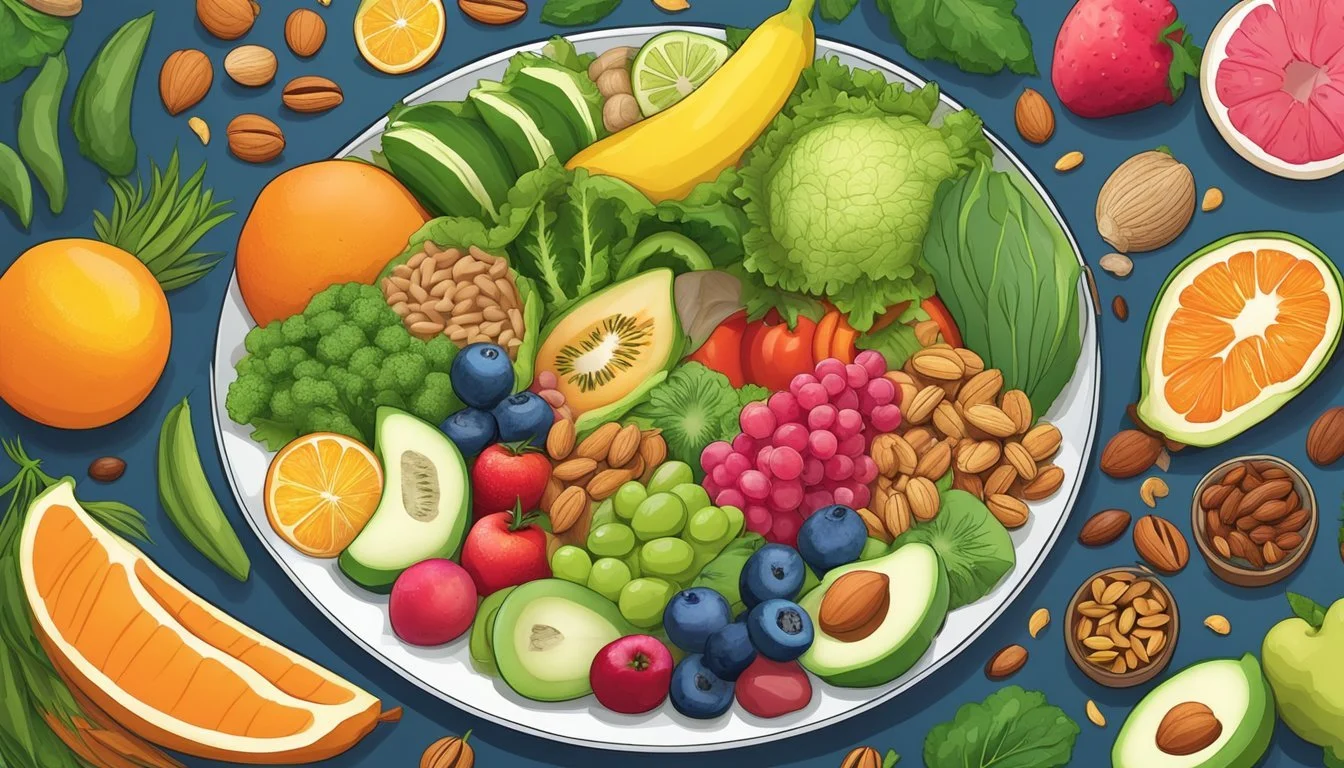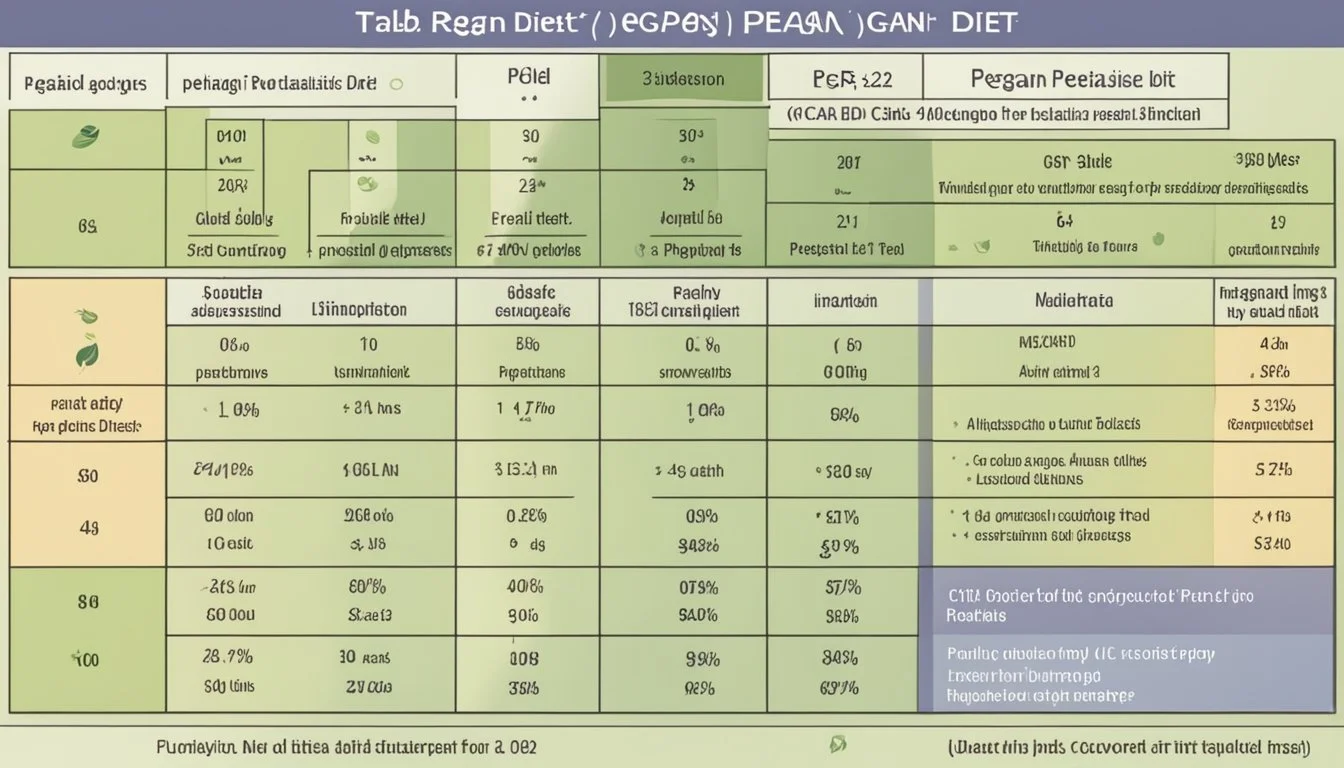The Truth About the Pegan Diet
Unveiling its Position in the Nutritional Landscape
The Pegan diet has emerged as a dietary approach that marries the principles of paleo and vegan diets, aiming to take advantage of the perceived benefits of both. Developed by Dr. Mark Hyman, it emphasizes a plant-rich eating pattern while incorporating lean meats, positing itself as a sustainable and health-forward choice. The core philosophy of the Pegan diet is the consumption of unprocessed, nutrient-dense foods which, according to its proponents, may reduce the risk of chronic diseases and curb inflammation.
Critics of the diet, however, question the practicality and nutritional completeness of such a hybrid regimen. By combining two seemingly opposite diets—one that excludes animal products and one that celebrates them—the Pegan diet raises both curiosity and skepticism within the nutrition community. As with any dietary plan, the efficacy and sustainability of the Pegan diet vary from person to person, and it's essential to evaluate its nutritional balance against individual health goals.
A closer look at the Pegan diet reveals that it is largely plant-based, with approximately 75% of each meal consisting of vegetables and fruits. The remaining portion includes high-quality proteins from sustainably raised animals. Grains, beans, dairy, and sugars are either greatly limited or avoided. The emphasis on whole foods over processed ones is a hallmark, with the goal of enhancing overall health and well-being. It’s the hybrid nature of the Pegan diet that has sparked a dialogue about its potential impact on health and whether it indeed offers the best of both dietary worlds.
Defining the Pegan Diet
The Pegan Diet, a term coined by Dr. Mark Hyman, is an eating philosophy that combines principles from both the paleo and vegan diets. This hybrid diet aims to capitalize on the health benefits of both eating styles while minimizing their respective limitations.
Paleo Foundations:
Prioritizes whole foods
Emphasizes proteins from animal sources
Avoids processed foods, grains, and dairy
Vegan Influences:
Concentrates on fruits and vegetables
Incorporates plant-based proteins
Excludes meat and animal products for ethical and health reasons
The Pegan Diet encourages a high intake of fruits and vegetables, making them the cornerstone of each meal. Proteins, particularly from sustainable and ethically sourced animal products, are included but in smaller portions compared to a traditional paleo diet. Processed foods, refined sugars, and most dairy products are excluded, reflecting veganism's avoidance of animal-derived products and processed items.
Key Components of the Pegan Diet:
Fruits and Vegetables: 75% of the plate
Protein: Sustainably sourced meats or plant-based substitutes
Fats: Emphasis on nuts, seeds, and omega-rich oils
This approach to eating marries the two diets’ strengths by offering ample nutrients through a primarily plant-based palette supplemented with high-quality proteins. The Pegan Diet also limits foods that often cause dietary sensitivities, such as gluten and dairy, aiming to promote overall health and wellness.
Overview of Paleo and Vegan Diets
The Paleo and Vegan diets are distinct in their principles and food choices with Paleo focusing on whole, unprocessed foods reminiscent of a pre-agricultural era, and Vegan emphasizing plant-based foods while eliminating all animal products.
Principles of the Paleo Diet
The Paleo diet is rooted in the idea of consuming foods presumed to be available to humans during the Paleolithic era. It prioritizes whole foods and advocates for:
High consumption of meats: Includes grass-fed meats, wild game, and fish.
Eggs: Seen as a natural and nutrient-dense food source.
Vegetables: A variety of non-starchy vegetables are encouraged.
Fruits: Typically low-glycemic fruits such as berries.
Nuts and seeds: These are included for their healthy fats and proteins.
Foods categorically excluded from the Paleo diet include:
Grains: All types of grains are avoided.
Dairy products: Dairy is excluded due to its absence in a Paleolithic human's diet.
Legumes: Beans, lentils, and other legumes are not consumed.
Processed foods and sugars: Highly processed foods and most sugars are eliminated.
Principles of the Vegan Diet
Conversely, the Vegan diet is centered around the exclusion of all animal products and byproducts. It emphasizes:
Plant-based foods: The core of the diet is made up of fruits and vegetables.
Grains: Whole grains are a staple for fiber and nutrients.
Nuts and seeds: Important for their protein and healthy fat content.
Among the non-permissible foods for Vegans are:
All animal products: This includes meat, poultry, fish, shellfish, eggs, and dairy products.
Animal-derived byproducts: Any product derivative from animals such as gelatin is not consumed.
Processed foods containing animal products: Vegans avoid processed foods that contain any form of animal products.
Both diets emphasize the minimization of processed foods and added sugars, promoting a focus on food quality and nutritional density.
Nutrition in a Pegan Diet
A Pegan diet combines principles from paleo and vegan diets, highlighting the importance of whole foods and nutrient density while being restrictive with certain food groups.
Focusing on Whole Foods
The foundation of the Pegan diet is a large variety of whole foods, which refers to foods that are not processed and remain as close to their natural state as possible. This includes:
Fruits: A range of low-glycemic fruits like cherries, strawberries, pears, and apples are encouraged for their vitamin, mineral, and fiber content.
Vegetables: Emphasis on an array of colorful vegetables, which form the bulk of the diet for fiber and essential nutrients.
Seeds and Nuts: For healthy fats and protein, options like almonds, chia seeds, and flaxseeds are included.
Healthy fats: Sourced from avocados, nuts, and seeds rather than refined oils.
Achieving Nutrient Balance
A balanced Pegan diet aims to provide a rich supply of protein, healthy fats, vitamins, and minerals while being mindful of the quantity and quality of these:
Protein: Modest portions of sustainably sourced animal products, such as eggs, chicken, lamb, and wild-caught fish.
Healthy fats: Omega-3 rich fish and monounsaturated fats from nuts and seeds are staples for cardiovascular and cognitive health.
Fiber: Found in abundance in fruits and vegetables, fiber is crucial for digestion and metabolic health.
Vitamins and Minerals: Consumed through a diverse intake of fruits, vegetables, nuts, and seeds.
Limits and Inclusions
The diet sets clear limits but also includes vital food categories to maintain balanced nutrition:
Legumes and Whole Grains: While moderate consumption of legumes and whole grains is permitted, they are not the diet's focal point due to their carbohydrate content.
Sugar: Highly restricted to minimize processed and sugar-added foods.
Dairy: Mostly excluded, with preference for dairy alternatives like unsweetened almond milk or coconut milk.
Fats: Trans fats and refined oils are to be avoided in favor of fats from whole food sources.
Health Benefits of Pegan Eating
The Pegan diet, a blend of paleo and vegan principles, focuses on whole, plant-based foods while including small amounts of high-quality protein. This eating pattern is designed to leverage the health benefits of both diets for improved well-being, with an emphasis on nutrient density and food quality.
Weight Management Strategies
The Pegan diet emphasizes whole foods with low glycemic indices, which can help in weight management by reducing calorie intake and promoting satiety. Foods like avocado and olive oil provide healthy fats that aid in fullness and can help prevent overeating. High fiber content from plant-based foods also helps in maintaining a healthy weight, as it slows digestion and extends the feeling of fullness.
Preventing and Managing Diabetes
Incorporating a low-glycemic diet, the Pegan approach supports stable blood sugar levels through the consumption of fiber-rich vegetables and low-glycemic fruits. The restriction of refined grains and sugars helps minimize insulin spikes. This could be beneficial for both diabetes prevention and management, as maintaining steady insulin and blood sugar levels is crucial.
Reducing Inflammation and Promoting Heart Health
Heart health is enhanced by the Pegan diet's focus on foods low in saturated fats and high in unsaturated fats like those in olive oil and avocado, which can help in reducing inflammation. It also encourages the avoidance of processed foods known to contribute to inflammation and heart disease. By focusing on these principles, the diet contributes to overall cardiovascular well-being.
Impact on Digestive Health
The Pegan diet promotes a healthy eating pattern that typically includes a variety of fiber-rich foods contributing to good digestive health. This high-fiber intake, from a diversity of vegetables and fruits, can aid in digestion and regularity. The diet also tends to be gluten-free, which can help those with gluten-related disorders by eliminating refined grains that often contain gluten.
How to Implement a Pegan Diet
Adopting a Pegan diet involves incorporating plant-based whole foods with a focus on fruits and vegetables, while including high-quality sources of protein like fish and lean meats in moderation. Careful planning and knowledge of nutrient-rich staples are crucial.
Pantry Staples and Shopping Tips
When embarking on the Pegan diet, focus on these staples:
Vegetables and Fruits: Stock up on a colorful array of seasonal and organic if possible.
Nuts and Seeds: Choose raw or lightly roasted without added sugars or salts.
High-quality Meats: Look for grass-fed, organic, or pasture-raised meats.
Sustainable Fish: Opt for low-mercury options like salmon or sardines.
Healthy Fats: Include olive and coconut oils.
Legumes and Grains: Select minimally processed types, such as quinoa and lentils.
Shopping Tips:
Always read labels to avoid added sugars and chemicals.
Prioritize local and organic produce to reduce exposure to pesticides.
Balance your cart with the principle that 75% should be plant-based and 25% from animal sources.
Sample Meal Plans and Recipes
Example of a Pegan Daily Meal Plan:
Meal Dish Breakfast Scrambled eggs with spinach and avocado Lunch Quinoa salad with roasted vegetables Dinner Grilled salmon (What wine goes well with grilled salmon?) with a mixed greens salad
Recipes should emphasize:
Simplicity: Dishes with few ingredients that showcase natural flavors.
Variety: Combining leafy greens, nuts, and seeds in salads, or incorporating fruits as sweet treats.
Preparation: Light cooking methods like steaming or sautéing to retain nutrient quality.
Eating Out and Social Events
To maintain the Pegan diet while eating out:
Choose restaurants that offer whole food options and are transparent about their sourcing.
Start with a salad to fill up on vegetables first.
Request modifications to dishes, such as dressing on the side or grilled instead of fried proteins.
At social events:
Offer to bring a Pegan-friendly dish that everyone can enjoy.
Scan the spread for whole food options, focusing on vegetables, fruits, and nuts.
Practice moderation, especially with foods outside the Pegan guidelines, and be mindful of portion sizes.
Common Challenges and Misconceptions
Navigating any diet can come with its own set of challenges and misconceptions, and the Pegan Diet is no exception. Careful consideration is required to understand its practicality and nutritional balance.
Debunking Pegan Diet Myths
The Pegan Diet merges principles from paleo and vegan diets, but common myths can cause confusion. One such myth is that the diet is protein-deficient due to the reduced meat intake; however, it emphasizes lean, sustainably raised meats and plant-based proteins. Another misconception is that Pegan followers cannot consume carbohydrates; in reality, they prioritize low-glycemic fruits and vegetables over processed grains. Lastly, the belief that Pegan is too restrictive overlooks its emphasis on diverse, nutrient-rich foods.
Expert Opinions and Scientific Evidence
Nutritionists, including Dr. Mark Hyman, suggest that the Pegan Diet might offer benefits such as reduced inflammation and chronic disease risk by encouraging whole foods and healthy fats. However, experts caution that its restrictions on dairy, legumes, and some grains could lead to nutritional deficiencies, particularly in calcium and certain vitamins. These concerns should be mitigated with careful meal planning and possible supplementation.
Addressing Nutrient Deficiencies
Adherents of the Pegan Diet may face challenges in consuming adequate levels of certain nutrients. Dairy is typically avoided, which raises questions about sufficient calcium intake. To counteract potential deficiencies, individuals should include sources like leafy greens and almonds. Legumes, a group often minimized in the Pegan Diet, are important for protein and fiber; thus, their limited consumption may necessitate incorporating alternative protein and fiber sources. For those concerned with adequate healthy fats, it’s essential to include items like avocados and nuts, which align with Pegan principles.
Environmental and Ethical Considerations
The Pegan diet intertwines ethical consumption and environmental sustainability with its emphasis on plant-based foods and ethically sourced animal products. It encourages the consumption of organic produce and grass-fed meats to minimize environmental impact and promote animal welfare.
Impact on Animal Welfare
In the Pegan diet, the limited intake of animal protein is ideally sourced from animals that are grass-fed and raised in humane conditions. This approach supports animal welfare by advocating for more natural livestock rearing practices. For instance, grass-fed beef is typically sourced from cattle that have been allowed to graze freely, leading to a better quality of life for the animals. Similarly, poultry should come from birds that have been raised with ample space and natural environments. These practices are not only considered more ethical but are also believed by some to result in more nutrient-dense meat for the consumer.
Sustainability of Pegan Choices
Sustainability lies at the heart of the Pegan diet through its:
Preference for organic produce: Pesticide-free and non-GMO plants are emphasized.
Reduction in overall meat consumption: While not excluding animal protein, the diet prescribes a plate where 75% is plant-based.
Focus on local sourcing: To minimize carbon footprint associated with transportation, locally sourced foods are recommended.
These choices make a Pegan diet potentially more planet-friendly. Organic farming practices are often regarded as more sustainable for the soil and the local ecosystems. Moreover, by advocating for a diet that is predominantly plant-based, the Pegan diet inherently reduces the demand for meat, which can lead to lower greenhouse gas emissions, a primary concern for the planet's health.
Comparative Analysis With Other Diets
This section presents a focused discussion contrasting the Pegan diet with Paleo, Vegan, and Mediterranean diets, each bearing distinct guidelines on whole grains, dairy, and sources of protein.
Pegan vs. Paleo
The Pegan diet is similar to the Paleo diet in its emphasis on whole, unprocessed foods and avoidance of refined sugar. However, while Paleo strictly eliminates all dairy and grains, Pegan allows for a moderate intake of whole grains and some dairy alternatives.
Paleo Diet: Focuses on foods presumed to have been eaten by early humans, such as lean meats, fish, fruits, vegetables, nuts, and seeds; excludes dairy, grains, and legumes.
Pegan Diet: Encourages a larger plant-based composition, considering environmental sustainability and allowing for about 25% of the diet comprising lean meats and a limited portion of whole grains and legumes.
Pegan vs. Vegan
The Pegan diet diverges markedly from the vegan diet by including animal products. Vegans avoid all animal-derived ingredients, thus excluding eggs, dairy, and meats. Yet, both diets share a high priority on plant-based foods.
Vegan Diet: Eliminates all animal products, often for ethical or environmental reasons, and emphasizes fruits, vegetables, legumes, nuts, and seeds.
Pegan Diet: Permits eggs and meats in moderation and focuses on fruits, vegetables, nuts, and seeds, aligning with the vegan approach on plant emphasis but providing a greater protein variety.
Pegan vs. Mediterranean Diet
When compared to the Mediterranean diet, Pegan also promotes high-quality fats and moderate seafood intake but is more restrictive regarding dairy and whole grains.
Mediterranean Diet: Characterized by high consumption of olive oil, fruits, vegetables, nuts, and seeds, along with moderate fish and dairy intake; whole grains and legumes are staples.
Pegan Diet: Similarly advocates for healthy fats, mainly from nuts and seeds, and includes fish as a clean protein source but limits grain and dairy consumption to smaller quantities.
Long-Term Considerations
Adopting the Pegan diet can have significant implications on one's health and day-to-day living. Careful planning and consideration are necessary to ensure it's sustainable and beneficial in the long run.
Maintaining a Pegan Lifestyle
Maintaining a Pegan lifestyle requires a strong commitment to whole foods and a balanced diet that merges plant-based eating with meat consumption in moderation. A Pegan diet emphasizes:
Fruits and Vegetables: These should make up 75% of one's diet, prioritizing low-glycemic fruits and a variety of vegetables.
Lean Proteins: The remaining 25% can consist of sustainably raised meats, emphasizing that these are an accompaniment rather than the centerpiece.
Healthy Fats: Including nuts, seeds, avocados, and omega-3 rich oils, which are integral to the diet.
One should also be mindful of:
The high cost and availability of organic and sustainably sourced ingredients.
The time and knowledge required to prepare balanced Pegan meals.
The social implications of dietary restrictions when dining out or with others.
Pegan Diet and Chronic Diseases
The Pegan diet's focus on whole foods and moderation aims to reduce the risk of chronic diseases such as obesity, heart disease, cancer, and type 2 diabetes. Its plant-rich component contributes to well-being by supplying essential vitamins, minerals, and fiber, which are key in preventing chronic conditions. Meanwhile, controlled portions of meat not only provide sufficient protein but can also help keep saturated fat intake low, a factor in mitigating heart disease risks. However, it's important to note:
No diet, including Pegan, guarantees full protection against chronic ailments. Genetics and other lifestyle factors also play a role.
Long-term adherence to any specific diet should be accompanied by regular medical checkups to monitor health markers.
Closing Thoughts
The Pegan diet merges the principles of paleo and vegan diets to potentially offer a balanced approach to nutrition. Its emphasis on whole foods and plant-based ingredients aligns with a health-conscious lifestyle, while the inclusion of lean meats caters to those seeking more protein variety.
Making Personalized Nutritional Choices
When considering the Pegan diet, individuals must assess their health goals, dietary preferences, and any potential restrictions. The diet's flexibility allows for customization to one's needs, potentially improving well-being. However, no one-size-fits-all solution exists in nutrition, and the Pegan diet is no exception. Individuals should consider the following aspects:
Whole Foods: A diet high in fruits, vegetables, and quality fats supports health, as per the Pegan diet's recommendations.
Lean Proteins: Including sustainably raised meats may benefit those who thrive on animal protein, as 25% of the Pegan plate suggests.
Lifestyle Fit: Adapting the Pegan principles to fit individual lifestyles may ensure long-term adherence and overall health enhancement.
Nutritional choices should be personalized, considering the unique circumstances and health of each individual. Those interested in the Pegan diet are advised to consult with healthcare providers to ensure it aligns with their specific health objectives and dietary requirements.










